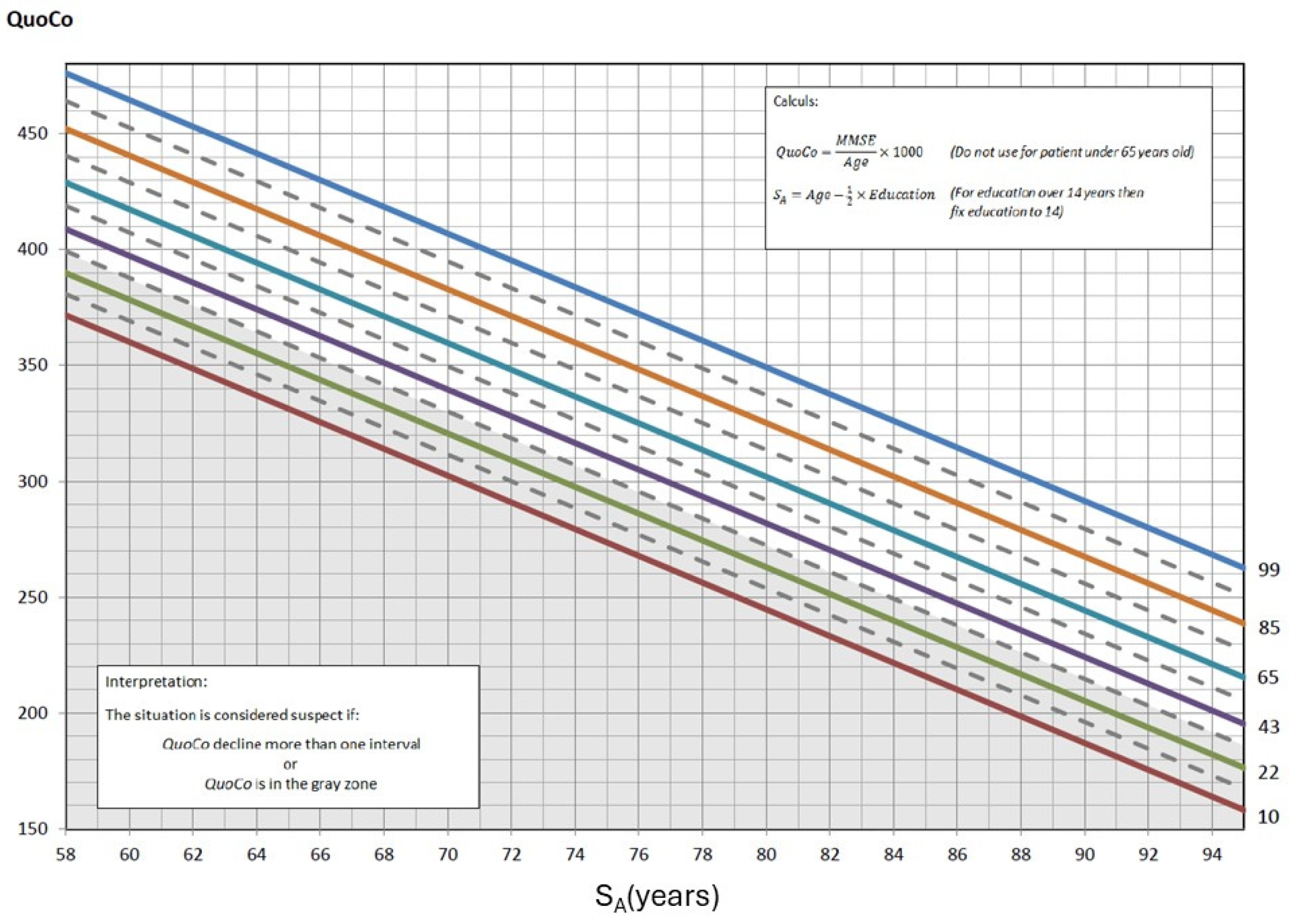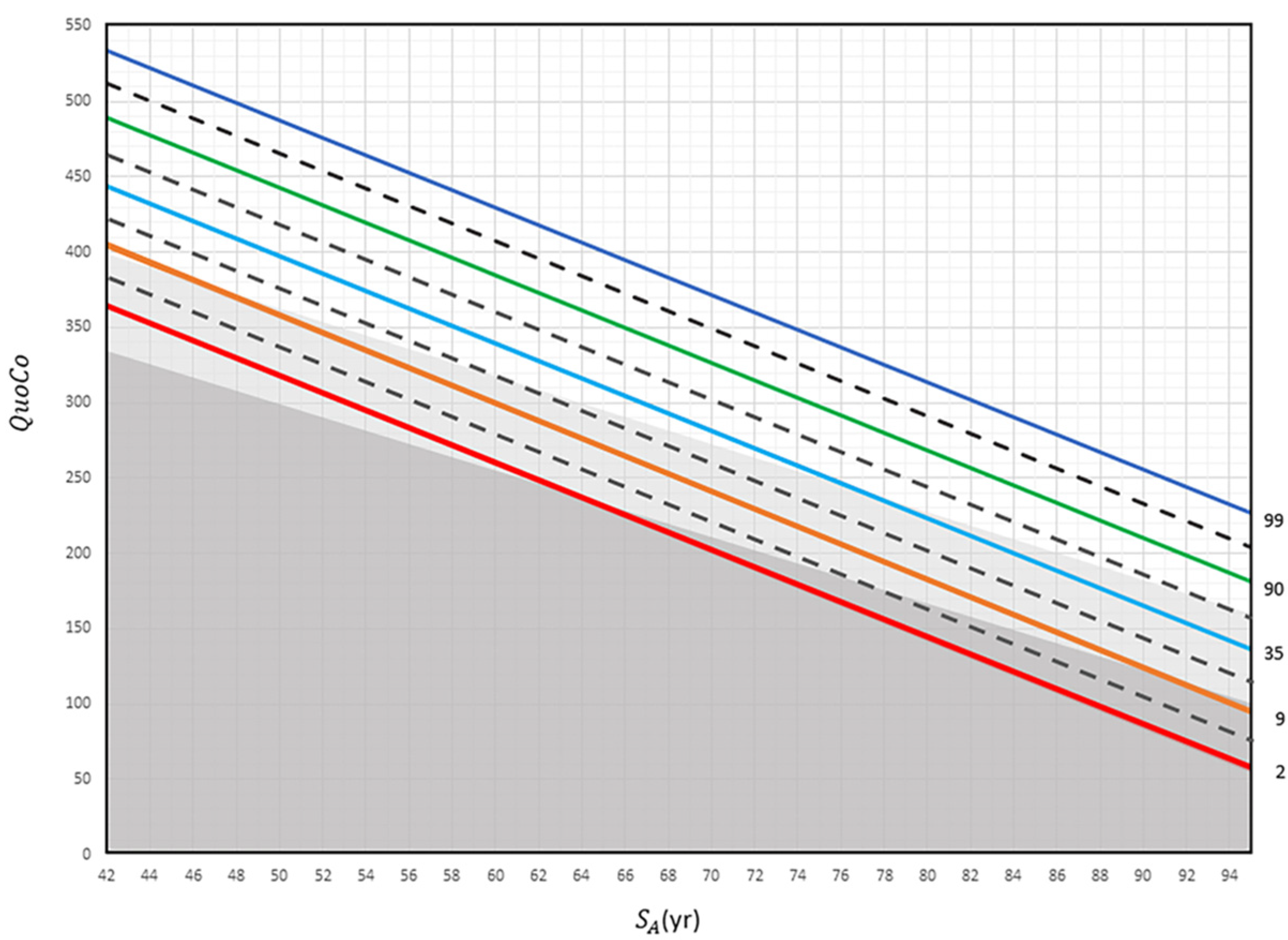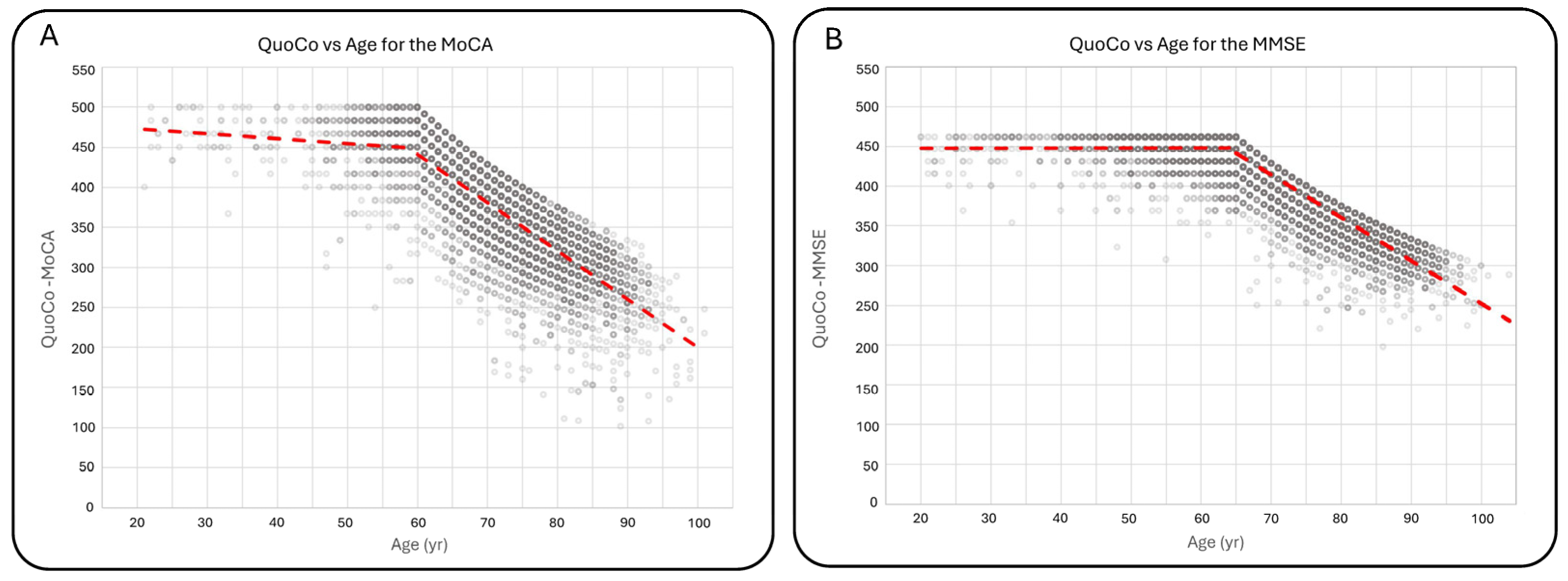Expanding the Applicability of Cognitive Charts to the Entire Age Span
Abstract
1. Introduction
1.1. Development of Cognitive Charts for the MMSE and MoCA
1.2. Advantages of Cognitive Charts
1.3. Limitation of Cognitive Charts to an Age Threshold
2. Materials and Methods
2.1. Study Sample
2.2. Statistical Analyses
3. Results
4. Discussion
Advantages, Limitations, and Future Directions
5. Conclusions
6. Patents
Supplementary Materials
Author Contributions
Funding
Institutional Review Board Statement
Informed Consent Statement
Data Availability Statement
Acknowledgments
Conflicts of Interest
Abbreviations
| CC | Cognitive Charts |
| AACD | Age-associated cognitive decline |
| MMSE | Mini-Mental State Examination |
| MoCA | Montreal Cognitive Assessment |
| MCI | Mild cognitive impairment |
| NACC-UDS | National Alzheimer’s Coordinating Center—Uniform Data Set |
| AD | Alzheimer’s disease |
| ROC | Receiver Operating Characteristic |
| SE | Sensitivity |
| SP | Specificity |
| CI | Confidence interval |
| QuoCo | Cognitive Quotient |
| SA | Standardized Age |
References
- González-Madrid, A.; Calfío, C.; González, A.; Lüttges, V.; Maccioni, R.B. Toward Prevention and Reduction of Alzheimer’s Disease. J. Alzheimers Dis. 2023, 96, 439–457. [Google Scholar] [CrossRef] [PubMed]
- Folstein, M.F.; Folstein, S.E.; McHugh, P.R. “Mini-mental state”. A practical method for grading the cognitive state of patients for the clinician. J. Psychiatr. Res. 1975, 12, 189–198. [Google Scholar] [PubMed]
- Bernier, P.J.; Gourdeau, C.; Carmichael, P.H.; Beauchemin, J.P.; Verreault, R.; Bouchard, R.W.; Kröger, E.; Laforce, R. Validation and diagnostic accuracy of predictive curves for age-associated longitudinal cognitive decline in older adults. CMAJ 2017, 189, 1472–1480. [Google Scholar] [CrossRef]
- Nasreddine, Z.S.; Phillips, N.A.; Bédirian, V.; Charbonneau, S.; Whitehead, V.; Collin, I.; Cummings, J.L.; Chertkow, H. The Montreal Cognitive Assessment, MoCA: A brief screening tool for mild cognitive impairment. J. Am. Geriatr. Soc. 2005, 53, 695–699, Erratum in J. Am. Geriatr. Soc. 2019, 67, 1991. https://doi.org/10.1111/jgs.15925. [Google Scholar] [CrossRef]
- Bernier, P.J.; Gourdeau, C.; Carmichael, P.H.; Beauchemin, J.P.; Voyer, P.; Hudon, C.; Laforce, R. It’s all about cognitive trajectory: Accuracy of the cognitive charts-MoCA in normal aging, MCI, and dementia. J. Am. Geriatr. Soc. 2023, 71, 214–220. [Google Scholar] [CrossRef]
- Ismail, Z.; Black, S.E.; Camicioli, R.; Chertkow, H.; Herrmann, N.; Laforce, R., Jr. Recommendations of the 5th Canadian Consensus Conference on the diagnosis and treatment of dementia. Alzheimers Dement. 2020, 16, 1182–1195. [Google Scholar] [CrossRef]
- Sims, J.R.; Zimmer, J.A.; Evans, C.D.; Lu, M.; Ardayfio, P.; Sparks, J.; Wessels, A.M.; Shcherbinin, S.; Wang, H.; Monkul Nery, E.S.; et al. Donanemab in Early Symptomatic Alzheimer Disease: The TRAILBLAZ-ER-ALZ 2 Randomized Clinical Trial. JAMA 2023, 330, 512–527. [Google Scholar] [CrossRef] [PubMed]
- van Dyck, C.H.; Swanson, C.J.; Aisen, P.; Bateman, R.J.; Chen, C.; Gee, M.; Kanekiyo, M.; Li, D.; Reyderman, L.; Cohen, S.; et al. Lecanemab in Early Alzheimer’s Disease. N. Engl. J. Med. 2023, 388, 9–21. [Google Scholar] [CrossRef]
- The Canadian Study of Health and Aging. Risk factors for Alzheimer’s disease in Canada. Neurology 1994, 44, 2073–2080. [Google Scholar] [CrossRef]
- 2020 Alzheimer’s disease facts and figures. Alzheimers Dement. 2020, 16, 391–460.
- El-Hayek, Y.H.; Wiley, R.E.; Khoury, C.P.; Daya, R.P.; Ballard, C.; Evans, A.R.; Karran, M.; Molinuevo, J.L.; Norton, M.; Atri, A. Tip of the iceberg: Assessing the global socioeconomic costs of Alzheimer’s disease and related dementias and strategic implications for stakeholders. J. Alzheimers Dis. 2019, 70, 323–341. [Google Scholar] [PubMed]
- Better, M.A. 2023 Alzheimer’s disease facts and figures. Alzheimers Dement. 2023, 19, 1598–1695. [Google Scholar]
- Livingston, G.; Huntley, J.; Liu, K.Y.; Costafreda, S.G.; Selbæk, G.; Alladi, S.; Ames, D.; Banerjee, S.; Burns, A.; Brayne, C.; et al. Dementia prevention, intervention, and care: 2024 report of the Lancet standing Commission. Lancet 2024, 404, 572–628. [Google Scholar] [CrossRef]
- Alzheimer’s Disease International; McGill University. World Alzheimer Report 2021; McGill University: Montréal, QC, USA, 2021. [Google Scholar]
- Weimer, D.L.; Sager, M.A. Early identification and treatment of Alzheimer’s disease: Social and fiscal outcomes. Alzheimers Dement. 2009, 5, 215–226. [Google Scholar] [CrossRef] [PubMed]
- Barnett, J.H.; Lewis, L.; Blackwell, A.D.; Taylor, M. Early intervention in Alzheimer’s disease: A health economic study of the effects of diagnostic timing. BMC Neurology 2014, 14, 101. [Google Scholar] [CrossRef]
- Grande, G.; Qiu, C.; Fratiglioni, L. Prevention of dementia in an ageing world: Evidence and biological rationale. Ageing Res. Rev. 2020, 64, 101–145. [Google Scholar] [CrossRef] [PubMed]
- Jia, X.; Wang, Z.; Huang, F.; Su, C.; Du, W.; Jiang, H.; Wang, H.; Wang, J.; Wang, F.; Su, W.; et al. A comparison of the Mini-Mental State Examination (MMSE) with the Montreal Cognitive Assessment (MoCA) for mild cognitive impairment screening in Chinese middle-aged and older population: A cross-sectional study. BMC Psychiatry 2021, 21, 485. [Google Scholar] [CrossRef]
- Dohm-Hansen, S.; English, J.A.; Lavelle, A.; Fitzsimons, C.P.; Lucassen, P.J.; Nolan, Y.M. The ‘middle-aging’ brain. Trends Neurosci. 2024, 47, 259–272. [Google Scholar] [CrossRef]
- Grigoletto, F.; Zappalà, G.; Anderson, D.W.; Lebowitz, B.D. Norms for the Mini-Mental State Examination in a healthy population. Neurology 1999, 53, 315–320. [Google Scholar] [CrossRef]
- Liu, H.C.; Teng, E.L.; Lin, K.N.; Hsu, T.C.; Guo, N.W.; Chou, P.; Hu, H.H.; Cheng, W.N.; Chiang, B.N. Performance on a dementia screening test in relation to demographic variables. Study of 5297 community residents in Taiwan. Arch. Neurol. 1994, 51, 910–915. [Google Scholar] [CrossRef]
- Scharre, D.W.; Chang, S.; Nagaraja, H.N.; Wheeler, N.C.; Kataki, M. Self-Administered Gerocognitive Examination: Longitudinal cohort testing for the early detection of dementia conversion. Alzheimer’s Res. Ther. 2021, 13, 192. [Google Scholar] [CrossRef]
- Dickerson, B.C.; Atri, A.; Clevenger, C.; Karlawish, J.; Knopman, D.; Lin, P.J.; Norman, M.; Onyike, C.; Sano, M.; Scanland, S.; et al. The Alzheimer’s Association clinical practice guideline for the Diagnostic Evaluation, Testing, Counseling, and Disclosure of Suspected Alzheimer’s Disease and Related Disorders (DETeCD-ADRD): Executive summary of recommendations for specialty care. Alzheimers Dement. 2025, 21, e14337. [Google Scholar] [CrossRef] [PubMed]




| Characteristics | Healthy Controls | Mild Cognitive Impairment | Incident Dementia | Prevalent Dementia |
|---|---|---|---|---|
| MoCA | ||||
| Participants < 60 years old (n = 1007) | n = 577 | n = 129 | n = 14 | n = 287 |
| Age at the start of the study, year | 51.59 ± 8.33 | 53.39 ± 6.99 | 53.14 ± 7.47 | 54.34 ± 5.25 |
| Education, year | 16.06 ± 2.45 | 15.76 ± 2.89 | 15.07 ± 2.59 | 14.84 ± 2.85 |
| MoCA score at the start of the study | 27.24 ± 2.40 | 23.94 ± 3.73 | 20.64 ± 3.95 | 14.01 ± 7.01 |
| MoCA score at the end of the study | 27.34 ± 2.34 | 23.97 ± 3.80 | 17.00 ± 6.64 | 12.99 ± 7.24 |
| Participants ≥ 60 years old (n = 9684) | n = 5168 | n = 2015 | n = 194 | n = 2308 |
| Age at the start of the study, year | 73.66 ± 77.67 | 75.59 ± 7.96 | 76.82 ± 7.70 | 75.32 ± 14.67 |
| Education, year | 16.24 ± 2.77 | 15.94 ± 2.97 | 16.35 ± 3.09 | 15.55 ± 3.12 |
| MoCA score at the start of the study | 26.11 ± 2.88 | 22.55 ± 3.56 | 20.95 ± 3.54 | 14.67 ± 6.00 |
| MoCA score at the end of the study | 26.13 ± 2.94 | 22.27 ± 3.68 | 18.06 ± 4.39 | 14.67 ± 6.00 |
| MMSE | ||||
| Participants < 65 years old (n = 5095) | n = 2712 | n = 22 | n = 2361 | |
| Age at the start of the study, year | 56.60 ± 7.85 | 57.05 ± 8.97 | 57.96 ± 5.49 | |
| Education, year | 16.39 ± 6.73 | 14.77 ± 3.19 | 16.34 ± 11.72 | |
| MMSE score at the start of the study | 29.18 ± 1.18 | 28.59 ± 1.37 | 19.96 ± 7.16 | |
| MMSE score at the end of the study | 29.21 ± 1.19 | 20.45 ± 7.06 | 16.15 ± 8.46 | |
| Participants ≥ 65 years old (n = 16,774) | n = 7076 | n = 533 | n = 9165 | |
| Age at the start of the study, year | 74.74 ± 7.03 | 79.60 ± 6.88 | 77.41 ± 7.02 | |
| Education, year | 15.90 ± 6.17 | 15.47 ± 7.06 | 14.66 ± 8.40 | |
| MMSE score at the start of the study | 28.83 ± 1.47 | 28.27 ± 1.74 | 19.66 ± 6.87 | |
| MMSE score at the end of the study | 28.73 ± 1.59 | 22.27 ± 5.59 | 16.88 ± 7.66 |
Disclaimer/Publisher’s Note: The statements, opinions and data contained in all publications are solely those of the individual author(s) and contributor(s) and not of MDPI and/or the editor(s). MDPI and/or the editor(s) disclaim responsibility for any injury to people or property resulting from any ideas, methods, instructions or products referred to in the content. |
© 2025 by the authors. Licensee MDPI, Basel, Switzerland. This article is an open access article distributed under the terms and conditions of the Creative Commons Attribution (CC BY) license (https://creativecommons.org/licenses/by/4.0/).
Share and Cite
Gourdeau, C.; Légaré-Baribeau, M.-P.; Bernier, P.; Laforce, R. Expanding the Applicability of Cognitive Charts to the Entire Age Span. Brain Sci. 2025, 15, 327. https://doi.org/10.3390/brainsci15040327
Gourdeau C, Légaré-Baribeau M-P, Bernier P, Laforce R. Expanding the Applicability of Cognitive Charts to the Entire Age Span. Brain Sciences. 2025; 15(4):327. https://doi.org/10.3390/brainsci15040327
Chicago/Turabian StyleGourdeau, Christian, Marie-Pierre Légaré-Baribeau, Patrick Bernier, and Robert Laforce. 2025. "Expanding the Applicability of Cognitive Charts to the Entire Age Span" Brain Sciences 15, no. 4: 327. https://doi.org/10.3390/brainsci15040327
APA StyleGourdeau, C., Légaré-Baribeau, M.-P., Bernier, P., & Laforce, R. (2025). Expanding the Applicability of Cognitive Charts to the Entire Age Span. Brain Sciences, 15(4), 327. https://doi.org/10.3390/brainsci15040327





